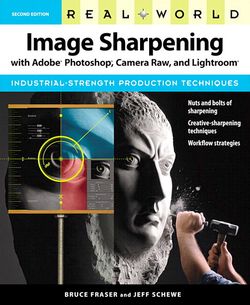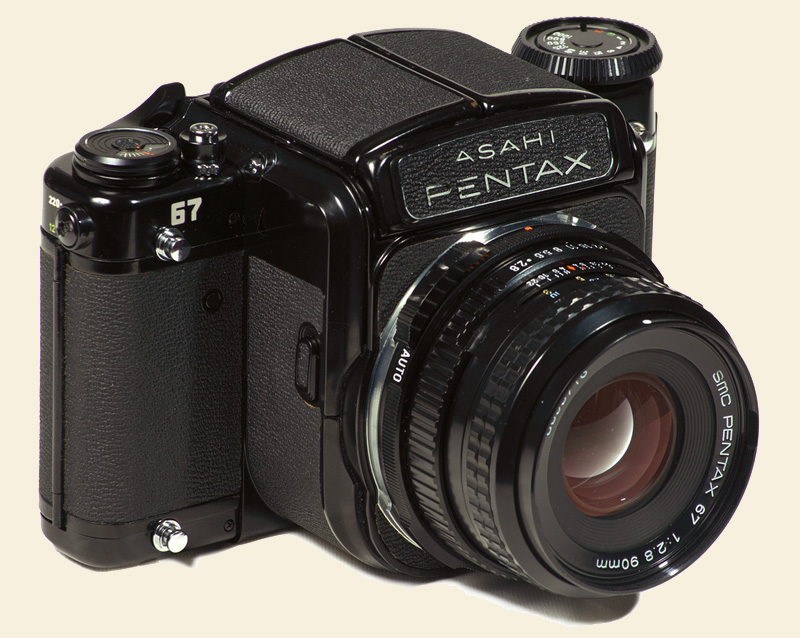
I contacted Jeff Schewe yesterday to pass along some questions from readers about his update of Bruce Fraser's book Image Sharpening .
.
First of all, he confirmed that there will be future updates to PhotoKit Sharpener, but declined to give me any details. I also asked him if he would speak to some of the differences between the first edition of Image Sharpening, which I have, and the second edition, which I haven't seen. And, specifically, whether people (such as, er, me) who already have the first edition should consider getting the second.
Here's what he said:
Well, the industry changed between the first edition and the second. The first thing is of course, we lost Bruce. But what really changed is the fact that Adobe incorporated a lot of what was in the book into Camera Raw and Lightroom. So, all of the capture sharpening in ACR & LR is based on Bruce's work. Additionally, Adobe incorporated the PhotoKit Sharpener output sharpening directly into Camera Raw and Lightroom.
So, the fundamental differences in the two editions is the fact that Photoshop is really only a portion of the creative sharpening and much more is written about Camera Raw and Lightroom–which wasn't released when the first edition was published. So, anybody with the old book will seriously want to update to the new edition.
Just my humble opinion. :~)
A couple of readers asked whether they really needed a whole book about sharpening. The answer is, no, of course you don't. Some people aren't interested in photographic craft at all. A few of those people are even photographers. I remember reading in Ralph Gibson's Darkroom —it might have been Darkroom 2, rather than the original—about a photographer who agitated his film by rolling the tank around on the floor with his foot while he smoked a cigarette. When the cigarette was done, it was time for the stop bath. Who needs anything so bourgeois as a timer? You could be the digital equivalent of that—snap the pic and however it looks is however it looks. Why sweat details?
—it might have been Darkroom 2, rather than the original—about a photographer who agitated his film by rolling the tank around on the floor with his foot while he smoked a cigarette. When the cigarette was done, it was time for the stop bath. Who needs anything so bourgeois as a timer? You could be the digital equivalent of that—snap the pic and however it looks is however it looks. Why sweat details?
And of course there's no reason to be a photographer at all. Other activities are healthy. I've just taken up cycling, for instance, and that's fun, except when it rains. You could be an audiophile. Being an audiophile means you don't have to do anything except spend money and listen to your stereo, and that's easy—no one knows if you're good at it or bad at it, at least not if you learn how to maintain a properly inscrutable silence and not gush on about things like $2,700 power cords and how freaking wonderful they "sound." (To answer Martin Doonan's question, you can make fun of $2,700 power cords for stereo components. That's safe. Now about that link, note that $2,700 is the price for a 1-meter power cord. The 2-meter version—under the pull-down menu—is $3,000. Does that mean the cable itself costs $300 per meter? That would mean the two plug doohickeys cost $1,200 each. That seems a little fishy to me. But maybe I'm just cheap, and don't appreciate how much a proper plug doohickey can cost.) Turning to alternative hobbies, there's always fabric arts. But that might take some skill and knowledge as well, I'm afraid. Is it true what they say, that anyone can learn to knit?
Stay away from woodworking. Knowledge and skill are requirements. Getting back to photography, it's probably a good thing, considering some of the photographers I know, that cameras don't involve high-powered motors combined with sharp cutting edges, although I heard once of a studio assistant who plugged his PC cable into the wrong outlet on the power pack and knocked himself unconscious with a giant electrical shock when he picked up the camera.
If you're interested in the craft of digital photography, I recommend Image Sharpening. But there's no requirement attached. You can do as you wish. You can make fun of it, like Brooks did. You can pass on it: I'll still like you, and you can still come around here every day, or three times a day, or once a week, whatever's convenient. You could do what I do with a lot of technical books, which would be to buy it and rummage around in it briefly and then ignore it completely for months on end. That is unfortunately what I've done with Matt Kloskowski's Layers , despite the fact that I really, really mean to read and study it, on account of I suck with layers, on account of I'm lazy and have poor mental habits when it comes to orderliness, as anyone reading this post has noticed by now. (Only a lazy, disorderly person would make all the changes to the base layer.) Owning a book you don't read and then continue to not read is useless, but hopeful. More hopeful than deciding not to buy it, and much more hopeful than making fun of it based on the title. Buying it and keeping it handy bespeaks intention, willingness in a general sense, and aspiration. The intention is just open-ended, is all. You intend to get to grips with the subject—just...later. Later, I'm gonna crack open my copy of Layers and read the whole
first chapter. If I don't get to it, then I'll do it later. Or, if I
have to, later. I own the book, so I'm good. But making fun of something before you know what it's all about, however, closes you to it. Brooks can't buy Image Sharpening now, can he? He's already ridiculed it in public, which is to declare it outside the pale.
, despite the fact that I really, really mean to read and study it, on account of I suck with layers, on account of I'm lazy and have poor mental habits when it comes to orderliness, as anyone reading this post has noticed by now. (Only a lazy, disorderly person would make all the changes to the base layer.) Owning a book you don't read and then continue to not read is useless, but hopeful. More hopeful than deciding not to buy it, and much more hopeful than making fun of it based on the title. Buying it and keeping it handy bespeaks intention, willingness in a general sense, and aspiration. The intention is just open-ended, is all. You intend to get to grips with the subject—just...later. Later, I'm gonna crack open my copy of Layers and read the whole
first chapter. If I don't get to it, then I'll do it later. Or, if I
have to, later. I own the book, so I'm good. But making fun of something before you know what it's all about, however, closes you to it. Brooks can't buy Image Sharpening now, can he? He's already ridiculed it in public, which is to declare it outside the pale.
And I will, I'm afraid, never know the sonic nirvana of a $2,700 power cord.
Come to think of it, Brooks is probably open-minded enough to have his mind changed about Image Sharpening. But I'm pretty hardened about the power cord thing, I'm afraid.
Image Sharpening is good. Maybe not as good as Bruce's first book
is good. Maybe not as good as Bruce's first book , which was, at the time I read it, the best technical book about digital photography I ever read, and which has also been updated by Jeff. But good. You should buy it. But you don't have to
, which was, at the time I read it, the best technical book about digital photography I ever read, and which has also been updated by Jeff. But good. You should buy it. But you don't have to .
.
Send this post to a friend
Featured Comment by John Taylor: "Oh by the bye I'm a woodworker and a photographer and I have to say that sharpness is far more important in woodworking than in photography when it comes to the quality of the final results."
Featured Comment by Brooks Jensen, Editor, LensWork Publishing: Okay, I apologize. I am contrite. I will buy the book. I will read it. I will learn. I suspect my photographs will, indeed, improve. And, I will do my best to curb my occasional snarkiness. I guess I just not-so-secretly long for simpler days when sharpness meant 'use a tripod.' But, as the cliché advises, we can't go back. So, on to the newer and better—and perhaps even sharper—future! Thanks for the nudge, Mike."
Featured [Partial] Comment by Mike in Montreal: "Just wanted to lay down some pro-sharpening advocacy because the anti side [in the comments] seems to be missing an important point. Digital sharpening is only initially about making pictures sharper or crisper. After posting hundreds of photos to my blog since last November, putting each and every one through Lightroom and then Photoshop, I've come to realize textural subtlety is the main benefit of a well-honed sharpening regime.
"Say you have concrete, skin, leaves, water and glass in the same photograph. Do you want them all to look as if they're made from the same material? Or would you like each element and edge to exist separately within the picture in a natural manner?
"Please don't think I'm speaking as an adept. Far, far from it. I'm more of a rookie-for-life kind of guy. I'm lucky if I can barely grasp scientific concepts. Any technical know-how I might have has been gleaned from sneak-a-peeks in bookstore photo sections or what I see here on the internet. But I've had a lot of practice in the last year and I can now say, at the very least, that sharpening, contrary to the common sneer, is what will prevent your photos from 'looking digital,' properly handled."
 Pentax 67 with waist-level finder and 90mm lens. Photo by Janne Moren.
Pentax 67 with waist-level finder and 90mm lens. Photo by Janne Moren.


